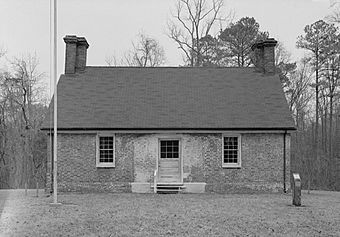Kiskiack (Lee House) facts for kids
|
Kiskiack
|
|

Kiskiack, HABS Photo
|
|
| Location | NE of jct. of VA 238 and 168, near Lackey, Virginia |
|---|---|
| Area | 0 acres (0 ha) |
| NRHP reference No. | 69000287 |
Quick facts for kids Significant dates |
|
| Added to NRHP | November 12, 1969 |
Kiskiack (Lee House) is a very old brick house built in the early 1600s. It was first a home for a family. Today, it stands on the Naval Weapons Station Yorktown in York County, Virginia. This brick building is the oldest one owned by the U.S. Navy. It is so important that it is listed on the National Register of Historic Places. The house was named after the historic Kiskiack tribe. They were an Algonquian-speaking group from the Powhatan Confederacy. This tribe lived in the area when English settlers first arrived.
Contents
Kiskiack: An Old House with a Story
Kiskiack is a special house because it has been around for a very long time. It tells a story about early life in Virginia. The house is located near Yorktown, Virginia, a place famous for its history.
What Does Kiskiack Look Like?
Kiskiack is a one-and-a-half story building. It has a roof that slopes steeply, like a triangle, at 55 degrees. The walls are made of brick laid in a special pattern called Flemish bond. This means the bricks are placed in a way that looks strong and pretty.
The house has a central hallway inside. The front of the house, facing west, looks balanced and even. There is a main door in the middle. A fire in 1915 damaged much of the inside. But the main structure of the house is still strong and well-kept. The T-shaped chimneys are a very unique part of the house's design.
Who Lived at Kiskiack?
The land where Kiskiack stands was bought in 1641. An English settler named Dr. Henry Harry Lee bought the property. He bought more land in 1650 and 1653. Dr. Lee was an important person in York County. He served as a judge in 1646. He was also chosen to be part of the House of Burgesses in 1656. This was an early form of government in Virginia.
Dr. Henry Lee married Marah Adkins Fulgate. Her father was a minister. He was the one who performed the wedding of Pocahontas and John Rolfe. Pocahontas was the daughter of the Powhatan chief.
The Lee Family's Connection
The Lee family owned the property for a very long time. They spelled the name of the property "Kiskiak." It is not known for sure if Dr. Henry Lee built the house himself. It might have been built by his son or grandson. The house's style fits the late 1600s.
Experts say Kiskiack is a rare example of an early Virginia country house. Its design and how it was built show the high quality of work from that time. There is also a small cemetery for the Lee family nearby.
Kiskiack Today
The Lee family owned Kiskiack until 1918. Then, the United States government bought the land. It became part of the Naval Mine Depot. This area later grew into the Naval Weapons Station Yorktown. Because it is a military base, the general public cannot visit the house.
A Special Table
Years later, a woman named Barbara Blunt Brooks from Richmond, Virginia, gave a special gift. She donated a table made by Dr. Henry Lee to the Naval Weapons Museum. This table is one of only two known to have been made by him. The location of the other table is not known.
How Kiskiack is Recognized
Kiskiack has been studied and photographed for the Historic American Buildings Survey (HABS). Many pictures of the house are available. It is officially recognized on the National Register of Historic Places. It is also listed on the Virginia Landmarks Register. These lists help protect important historical places.



